French Bulldog Colors: Standard vs Non-Standard Coat Colors

French Bulldogs are beloved for many reasons, from their playful personalities to their compact size. Another reason they are so cherished is the variety of colors they come in. From fawn to brindle to rare shades like blue and lilac, these colors add to the breed’s unique charm.
In this article, we’ll explore the different colors of French Bulldogs, including standard and non-standard colors, to give you a better understanding of the fascinating world of French Bulldog colors.
Understanding Standard French Bulldog Colors and Patterns
French Bulldogs are a dog breed that is popular for their charming personalities and unique coat colors. The breed is recognized by the American Kennel Club (AKC) and has strict breed standards in place. These standards provide guidelines for coat colors that are accepted and expected in the breed.
The most common Frenchie colors that are recognized by breed standards include:
Color | Description |
Fawn | A light tan color ranging from creamy white to reddish-brown. |
Brindle | A pattern of stripes or streaks of color over a solid base color. The stripes can be black, dark brown, or gray. |
Pied | A mostly white coat with patches of any other color, often including the face and ears. |
These colors and their variations are widely accepted in the breed and are often the most sought-after by French Bulldog enthusiasts. Breeders work to maintain the purity of these colors while striving to produce high-quality and healthy French Bulldogs.
Next, we’ll explore the fawn color category and the different shades and patterns that can be found within that group.
Fawn French Bulldogs: Shades and Patterns

Fawn is one of the most common coat colors found in French Bulldogs, but did you know that several unique shades and patterns fall under this category? From the classic light tan to the striking red fawn, fawn Frenchies come in a range of beautiful hues.
One of the most distinctive fawn coat patterns is the “black mask,” where the Frenchie has a black facial mask that contrasts against their light coat. This pattern is a characteristic of the breed and adds to their unique charm.
Another stunning fawn pattern is the “sable fawn,” where the Frenchie has dark hair mixed in with its lighter fawn coat. The result is a coat that has a multi-toned, textured appearance.
Fawn Coat Color Genetics
The fawn coat color is determined by the dog’s genes, specifically the AY allele which determines whether the dog will have a fawn or non-fawn coat. However, the shade and pattern within the fawn category can also be influenced by other genes, making each Frenchie’s coat truly unique.
Fawn Coat Shades and Patterns | Genetic Markers |
Light Fawn | ay, at |
Red Fawn | ay, a |
Sable Fawn | ay, kyky, at |
Black Mask Fawn | ay, at, Em |
While fawn Frenchies are generally healthy, it’s important to note that they may be prone to skin allergies and irritations due to their sensitive skin. Regular grooming and care can help minimize these issues.
Overall, fawn French Bulldogs are a delightful and beloved color variation within the breed, cherished for their sweet temperaments and striking appearances.
Brindle Beauties: Patterns and Markings
The brindle coat pattern is one of the most popular among French Bulldogs. Brindle coats typically range from light to dark and are composed of a dark base color overlaid with lighter-colored stripes. The stripes can be thin or thick and can vary in frequency and distribution across the body.
Description | |
Classic Brindle | The classic brindle pattern features dark stripes on a fawn or tan base. This pattern is commonly seen in French Bulldogs and is the most recognized brindle pattern. |
Reverse Brindle | The reverse brindle pattern features lighter stripes on a dark base color, creating a unique and eye-catching appearance. This pattern is less common but highly sought after. |
Pied Brindle | The pied brindle pattern features patches of brindle mixed with white patches, creating a striking contrast of color. This pattern can be seen in both brindle and pied French Bulldogs. |
The brindle coat pattern is thought to be caused by a combination of genes that produce bands of pigment on the hair shaft. The unique pattern and color variation found in brindle French Bulldogs add to the breed’s charm and appeal.
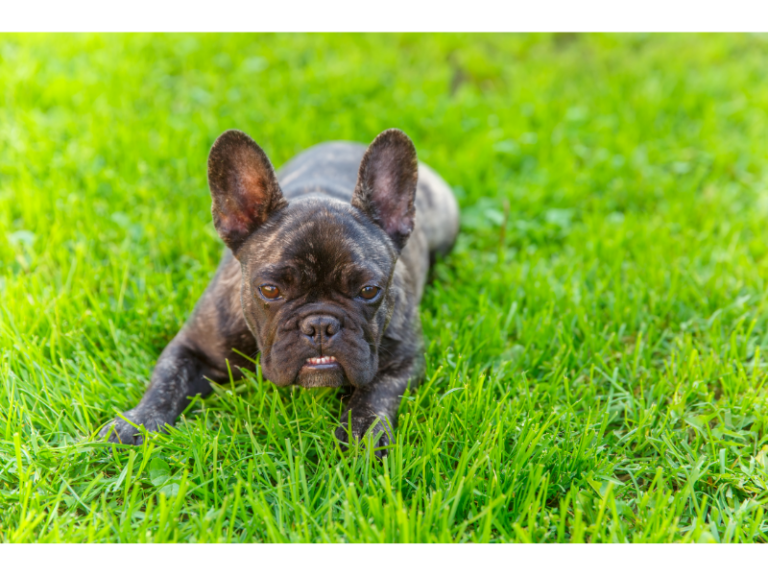
Pied French Bulldogs: Patches of Charm
Pied French Bulldogs are known for their unique appearance, with patches of colors on their predominantly white coat. These charming dogs are a favorite among many French Bulldog enthusiasts, thanks to their eye-catching coat patterns that make them stand out among their peers.
The pied coat pattern is the result of the piebald gene, which creates random white patches on a colored coat. The size and location of the patches can vary widely between dogs, giving each pied Frenchie a one-of-a-kind look.
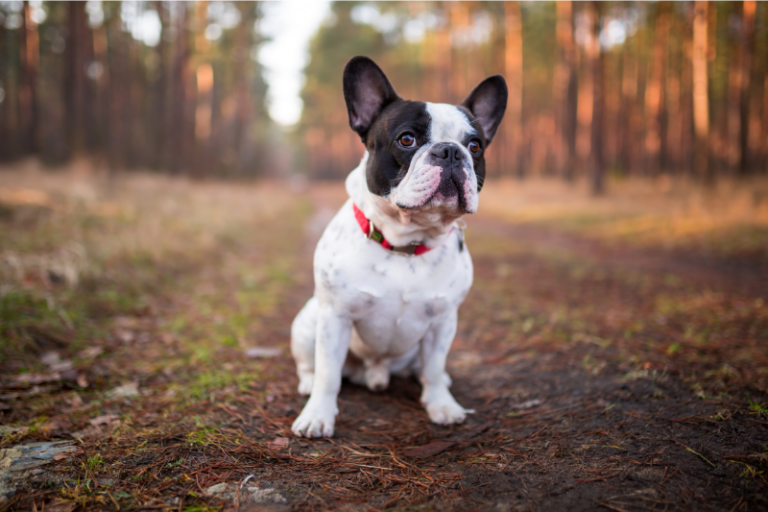
While the piebald gene is not exclusive to the French Bulldog breed, it is particularly prevalent and desirable within the community. The pied coat pattern is recognized as a standard color by many breed clubs and accepted in the breed standard.
It’s important to note that pied French Bulldogs can have different base colors, including fawn, brindle, and black. While white is the dominant color on the coat, some pied Frenchies may have more pigmented patches. This can result in unique variations within the pied color category, such as brindle pied and fawn pied.
If you’re considering adding a pied French Bulldog to your family, it’s essential to choose a reputable breeder who adheres to ethical breeding practices. This can help minimize the risk of health issues associated with coat color, such as deafness, that can occur in some pied dogs.
Rare French Bulldog Colors
French Bulldogs are known for their unique and eye-catching coats, and non-standard colors are no exception. In this section, we’ll take a closer look at some of the rare and unconventional coat colors found in French Bulldogs.
Blue and Lilac French Bulldogs
Blue Frenchies have a coat that ranges from a pale gray to a deep charcoal. Lilac Frenchies have a similar color palette, with a pinkish hue mixed in. These rare colors occur when a French Bulldog inherits the dilution gene from both parents. Some breeders argue that these colors are not desirable due to possible health concerns, but they remain popular choices among some owners.
Color | Description | Image |
Blue | A range of grayish-blue shades. | 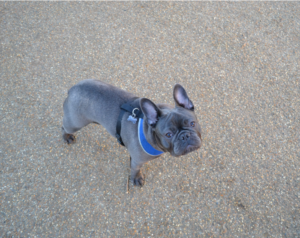 |
Lilac | A range of lighter shades with a pinkish hue. | 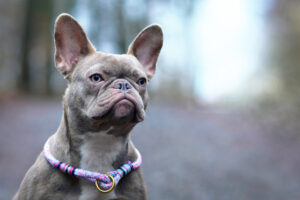 |
Chocolate French Bulldogs
Chocolate French Bulldogs have a dark, rich brown coat. This color results from inheriting a recessive gene from both parents. Because this color is unusual in French Bulldogs, chocolate puppies are often in high demand and can come with a higher price tag.
Color | Description | Image |
Chocolate | A rich brown coat color. | 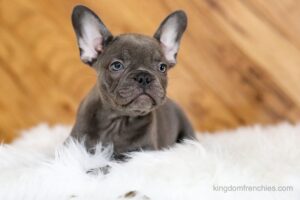 |
Merle French Bulldogs
Merle French Bulldogs have a patchy coat pattern with a marbled or speckled appearance that can vary greatly from dog to dog. This coat pattern results from a mutation of the merle gene, which is not recognized by some French Bulldog breed standards.
Color | Description | Image |
Merle | A patchy coat pattern with various colors. |  |
While these colors may be less common, they still make for beautiful French Bulldogs with unique personalities. However, it’s important to note that some of these colors may come with more health risks, so always choose a reputable breeder who is transparent about their breeding practices and any associated risks.
French Bulldog Coat Color Genetics
French Bulldogs’ coat colors are determined by their genetics, specifically by the genes they inherit from their parents. By understanding the basics of coat color genetics, you can better comprehend why some colors are dominant while others are recessive, and why certain coat combinations are more likely to occur.
The two main types of genes that affect French Bulldog coat colors are E and K. The E gene controls whether a French Bulldog expresses a color or not, while the K gene affects the distribution of color on the dog’s coat. This gene determines whether a dog is solid-colored or has a pattern such as brindle or piebald.
In total, there are nine different alleles, or variations, of the E and K genes, creating various possible combinations for French Bulldog coat colors. For instance, a dominant E gene will lead a dog to have one of the four standard French Bulldog colors: fawn, brindle, black, or pied. On the other hand, the recessive E gene will create rarer colors, such as blue, lilac, and chocolate. Meanwhile, the K gene can produce unique markings such as spots or stripes in the coat.
Interestingly, coat color genetics can impact French Bulldog’s health. Dilute colors such as blue and lilac have been linked to potential skin and ear problems in some Frenchies. Having a basic understanding of coat color genetics can help breeders and owners make informed decisions when choosing their dogs and recognizing potential health problems.
Overall, French Bulldog coat color genetics provides fascinating insights into the breed. By recognizing the different types of coat colors and how they are inherited, you will better grasp the uniqueness and beauty of each Frenchie.
Frenchie Color-Related Health Concerns
Caring for French Bulldog Coats
French Bulldogs are beloved for their unique and beautiful coat colors, but some colors are associated with health risks. As a responsible owner, it’s important to be aware of these potential concerns.
Fawn French Bulldogs are prone to skin allergies and infections due to their short hair and wrinkles. Keeping their skin folds clean and dry can help prevent these issues.
Brindle French Bulldogs may be at risk for hearing and vision problems due to the presence of the merle gene in some brindle coat patterns. It’s important to have your Brindle Frenchie checked regularly by a veterinary specialist to monitor any potential issues.
Pied French Bulldogs may be prone to deafness, a congenital condition that can occur in dogs with white coats and blue eyes. Having your Pied Frenchie’s hearing tested as a puppy and throughout their life is important.
Coat Color | Associated Health Risks |
Fawn | Skin allergies and infections |
Brindle | Possible hearing and vision issues with different brindle coat patterns |
Pied | Deafness and hearing loss |
The risks associated with rare French Bulldog colors such as lilac, blue, and chocolate are less clear, but some breeders suggest that these colors may be linked to increased health problems such as breathing difficulties and immune system issues. It’s essential to do thorough research before purchasing a rare-colored French Bulldog and to choose a reputable breeder who prioritizes the health and well-being of their dogs.
As with any breed, regular veterinary checkups and proper nutrition and care can help prevent and manage many health issues. By being aware of potential color-related health concerns, you can help ensure that your beloved French Bulldog stays happy and healthy for years to come.
Caring for French Bulldog Coats
Grooming is an essential part of maintaining your French Bulldog’s coat. Regular grooming helps keep their coat healthy, shiny, and free from tangles. Different coat colors may have specific care requirements, so it’s essential to know how to care for your Frenchie’s unique coat to keep them looking their best.
Brushing
Regular brushing is necessary to keep your Frenchie’s coat clean and free of tangles or mats. For Frenchies with a short, smooth coat, a soft bristle brush or grooming mitt can be used to remove dirt and loose hair. For Frenchies with a longer or thicker coat, a slicker brush can help remove tangles and debris.
Bathing
Bathing your Frenchie is essential, but it’s crucial to use a gentle, dog-specific shampoo and avoid getting water in their ears. After bathing, towel dry your Frenchie and avoid using a hairdryer, as it can damage their sensitive skin.
Trimming
Trimming your Frenchie’s nails regularly can help prevent them from breaking or splitting. You can also trim the hair around their paws to keep them clean and free from mats. If you’re unsure about trimming your Frenchie’s hair or nails, seek advice from a professional dog groomer.
Diet
Your Frenchie’s diet plays a vital role in their coat and overall health. A balanced diet that includes essential fatty acids can help keep their coat shiny and healthy. Ensure your Frenchie has access to clean, fresh water at all times.
By following these grooming tips and paying attention to your Frenchie’s unique coat color and needs, you can help keep them looking and feeling their best.
Recognizing Coat Color Misrepresentation
When looking to add a French Bulldog to your family, it’s important to be aware that some breeders or sellers may misrepresent a dog’s coat color. This can lead to disappointment and frustration down the road. Here are some tips on how to recognize and navigate potential color misrepresentation:
Do your research: familiarize yourself with the different French Bulldog coat colors and their variations.
Ask questions: reputable breeders should be able to provide detailed information on a dog’s coat color genetics.
Request photos and videos: seeing a dog’s coat color in various lighting conditions can help you spot any discrepancies.
Beware of vague or misleading claims: if a breeder or seller is using terms like “rare” or “one-of-a-kind” to describe a coat color, proceed with caution.
Be willing to walk away: if you suspect that a breeder or seller is misrepresenting a dog’s coat color, it’s better to look elsewhere.
By being aware of these potential issues, you can ensure that you’re getting accurate information when selecting a French Bulldog with the coat color that you desire.
Remember, honesty is the best policy – this is especially true when it comes to buying or breeding French Bulldogs with unique coat colors.
Conclusion
In conclusion, French Bulldogs are a popular breed known for their adorable looks and distinct personality. Their coat colors add another layer of uniqueness to this already special breed. Whether you prefer the standard colors recognized by breed standards or the rarer non-standard hues, there is a French Bulldog color for everyone.
It is important to understand the genetics and potential health concerns related to French Bulldog coats to ensure you can care for your furry friend properly. Remember to always do thorough research when selecting a breeder or seller to ensure that the information provided is accurate and trustworthy.
With proper care and attention, your French Bulldog’s coat, regardless of its color, will remain a beautiful and defining characteristic of their personality. So love and cherish your Frenchie, and let their coat color be a shining symbol of their unique individuality.
FAQs About French Bulldog Colors
What are the different colors found in French Bulldogs?
French Bulldogs come in a variety of colors, including standard colors recognized by breed standards and non-standard or rare hues.
What are the standard colors of French Bulldogs?
The standard colors recognized in French Bulldogs include fawn, brindle, and pied, among others.
What is a fawn French Bulldog?
A fawn French Bulldog has a coat that is typically a warm, light tan color. There can also be variations within the fawn color, such as cream or pale fawn.
What are the coat patterns seen in fawn French Bulldogs?
Fawn French Bulldogs can have various coat patterns, including solid fawn, fawn with white markings, or fawn with brindle markings.
What is a brindle French Bulldog?
A brindle French Bulldog has a coat that consists of a base color with darker streaks or stripes. The base color can vary, but it is typically fawn or brindle.
What are the distinct brindle coat patterns in French Bulldogs?
Brindle French Bulldogs can have a range of coat patterns, including classic brindle, reverse brindle, or brindle with white markings.
What is a pied French Bulldog?
A pied French Bulldog has a predominantly white coat with patches of color. The patches can be in various colors, such as fawn, brindle, or black.
What are the unique coat patterns in pied French Bulldogs?
Pied French Bulldogs can have different coat patterns, such as evenly distributed patches, large patches on specific areas of the body, or a predominantly white coat with small patches.
What are the rare colors found in French Bulldogs?
Rare colors in French Bulldogs include blues, lilacs, chocolates, and merles. These colors are considered non-standard and are less commonly seen.
How do French Bulldog coat colors inherit?
The genetics behind French Bulldog coat colors involve the inheritance of specific genes that determine the pigmentation of the coat. Different combinations of genes can result in different coat colors.
Are there any health concerns related to French Bulldog coat colors?
Some French Bulldog coat colors may be associated with specific health concerns. For example, blue French Bulldogs can be more prone to skin issues. It is essential to be aware of potential health risks related to certain coat colors.
How should I care for different French Bulldog coat colors?
Different coat colors may require specific care. Regular grooming, including brushing and bathing, is essential for maintaining the coat’s health and appearance. It is recommended to consult a professional groomer for guidance on caring for specific coat colors.
How can I recognize coat color misrepresentation in French Bulldogs?
To recognize coat color misrepresentation, it is important to do thorough research, ask for reputable breeders’ recommendations, and be cautious of sellers making misleading claims about coat colors. Request documentation or genetic testing if needed to ensure accurate information.
Sources:
Vet Playas Veterinary Clinic: French Bulldog Colors: Common And Rare
Animal DNA diagnostics: French Bulldog Coat Colour Panel
National Library of Medicine: Coat color and coat color pattern-related neurologic and neuro-ophthalmic diseases
